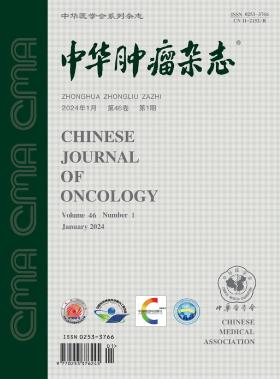[A real world study on the relationship between drug resistance of targeted therapy and prognosis of HER-2-positive advanced breast cancer].
Q3 Medicine
引用次数: 0
Abstract
Objective: To explore the effect of primary and acquired resistance to anti-human epidermal growth factor receptor 2 (HER-2) on the overall survival of patients with HER-2 positive advanced breast cancer. Methods: The clinical characteristics of HER-2 positive patients with advanced breast cancer admitted to Cancer Hospital of Chinese Academy of Medical Sciences from January 1998 to December 2018 were collected, and their neoadjuvant/adjuvant and advanced three-line chemotherapy were summarized. Among them, targeted drugs for HER-2 included trastuzumab, pertuzumab, T-DM1, RC48-ADC, lapatinib, pyrotinib, allitinib, sipatinib, seratinib. Based on the duration of benefit from anti HER-2 treatment, the patients were divided into two groups: primary anti HER-2 resistance group and acquired anti HER-2 resistance group. In this study, the overall survival (OS) was used as the main end point. Kaplan-Meier analysis and Cox proportional risk regression model were used to analyze the effects of different drug resistance mechanisms on the overall survival. Results: The whole group of 284 patients were included. The median age of recurrence and metastasis was 48 years old, 155 (54.6%) were hormone receptor (HR) positive and 129 (45.4%) were HR negative, 128 cases (45.1%) were premenopausal and 156 cases (54.9%) were postmenopausal, 277 cases (97.5%) had a score of 0-1 in ECoG PS and 7 cases (2.5%) had a score of more than 2 in the first diagnosis of relapse and metastasis. There were 103 cases (36.3%) in the primary drug resistance group and 181 cases (63.7%) in the secondary drug resistance group. The median overall survival time of the two groups was 24.9 months and 40.4 months, respectively, with statistical significance (P<0.001). Conclusion: Primary resistance to HER-2 is one of the factors of poor prognosis in HER-2 positive breast cancer, and its mechanism needs to be further explored.[her -2阳性晚期乳腺癌靶向治疗耐药与预后关系的现实研究]。
目的:探讨抗人表皮生长因子受体2 (HER-2)原发耐药和获得性耐药对HER-2阳性晚期乳腺癌患者总生存率的影响。方法:收集1998年1月至2018年12月中国医学科学院肿瘤医院HER-2阳性晚期乳腺癌患者的临床特点,总结其新辅助/辅助及晚期三线化疗情况。其中,HER-2靶向药物包括曲妥珠单抗、帕妥珠单抗、T-DM1、RC48-ADC、拉帕替尼、罗替尼、阿利替尼、西帕替尼、塞拉替尼。根据抗HER-2治疗的获益时间,将患者分为两组:原发性抗HER-2耐药组和获得性抗HER-2耐药组。本研究以总生存期(OS)为主要终点。采用Kaplan-Meier分析和Cox比例风险回归模型分析不同耐药机制对总生存率的影响。结果:全部纳入284例患者。复发和转移的中位年龄为48岁,激素受体(HR)阳性155例(54.6%),HR阴性129例(45.4%),绝经前128例(45.1%),绝经后156例(54.9%),ECoG PS评分0-1分277例(97.5%),首次诊断复发和转移评分大于2分7例(2.5%)。一次耐药组103例(36.3%),二次耐药组181例(63.7%)。两组患者的中位总生存时间分别为24.9个月和40.4个月,差异有统计学意义(P<0.001)。结论:HER-2原发耐药是HER-2阳性乳腺癌预后不良的因素之一,其机制有待进一步探讨。
本文章由计算机程序翻译,如有差异,请以英文原文为准。
求助全文
约1分钟内获得全文
求助全文

 求助内容:
求助内容: 应助结果提醒方式:
应助结果提醒方式:


